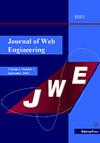Discovery of Modularity in Monolithic Java Project Codes Using Complex Networks
IF 1
4区 计算机科学
Q4 COMPUTER SCIENCE, SOFTWARE ENGINEERING
引用次数: 0
Abstract
Monolithic architecture is a software design which brings significant difficulties to system developers when it comes to maintenance or expanding the scope of a project. On the other hand, a modular project consists of several similar entities, or modules, which are the object of similar functions or processes that, applied repeatedly, have well-defined classes and smaller modules to work, bringing benefits such as reduced project development time and increased productivity for the system developers. This work proposes the use of complex networks through the NetworkX library in Python, using modularity detection algorithms for the static analysis of Java code. The goal is to discover modules by analyzing dependencies between classes, indicating the best way to identify code clusters to be treated as modules automatically. The outcomes of applying the Greedy Modularity, Louvain, K-Clique, and Girvan Newman algorithms to two open-source projects will be presented. A comparative analysis of these results will be illustrated using generated graphs and a distribution map, emphasizing the number of communities identified by each algorithm.在使用复杂网络的单片Java项目代码中发现模块化
单片架构是一种软件设计,当涉及到维护或扩展项目范围时,它给系统开发人员带来了巨大的困难。另一方面,模块化项目由几个相似的实体或模块组成,它们是相似功能或过程的对象,重复应用,具有定义良好的类和较小的模块来工作,为系统开发人员带来诸如减少项目开发时间和提高生产力之类的好处。这项工作提出了通过Python中的NetworkX库使用复杂网络,使用模块化检测算法对Java代码进行静态分析。我们的目标是通过分析类之间的依赖关系来发现模块,并指出自动识别要作为模块处理的代码集群的最佳方法。将贪婪模块化、Louvain、K-Clique和Girvan Newman算法应用于两个开源项目的结果。将使用生成的图形和分布图对这些结果进行比较分析,强调每种算法确定的社区数量。
本文章由计算机程序翻译,如有差异,请以英文原文为准。
求助全文
约1分钟内获得全文
求助全文
来源期刊

Journal of Web Engineering
工程技术-计算机:理论方法
CiteScore
1.80
自引率
12.50%
发文量
62
审稿时长
9 months
期刊介绍:
The World Wide Web and its associated technologies have become a major implementation and delivery platform for a large variety of applications, ranging from simple institutional information Web sites to sophisticated supply-chain management systems, financial applications, e-government, distance learning, and entertainment, among others. Such applications, in addition to their intrinsic functionality, also exhibit the more complex behavior of distributed applications.
 求助内容:
求助内容: 应助结果提醒方式:
应助结果提醒方式:


